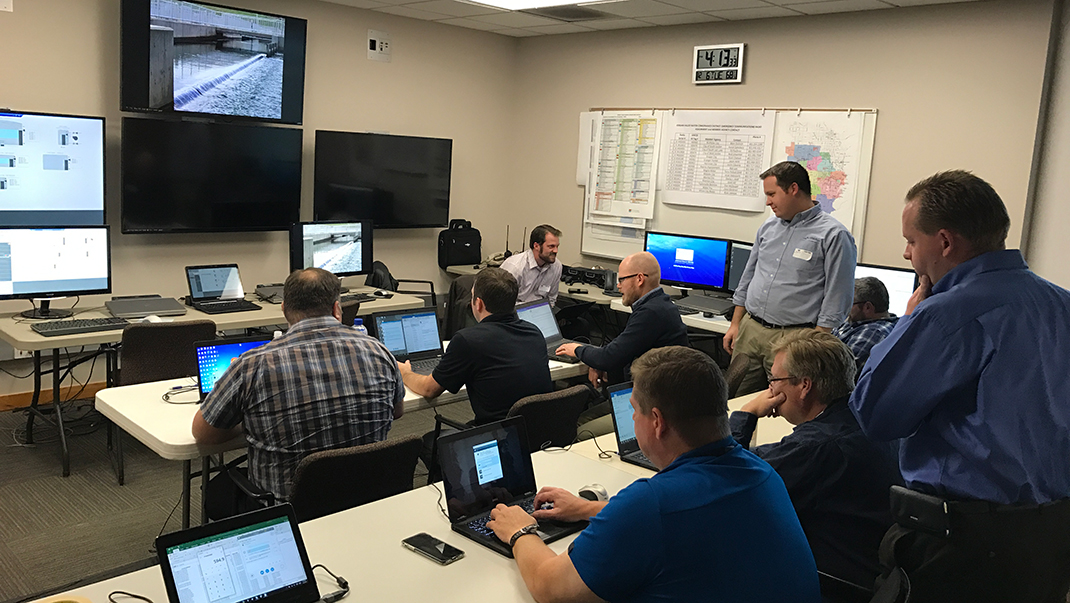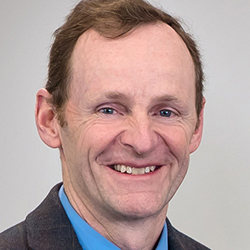One of Utah’s largest water districts, Jordan Valley Water Conservancy District, is responsible for providing a sustainable water future to a number of the fastest growing cities in the country. Brown and Caldwell Utah Operations Leader Jacob Young recently sat down with Alan Packard, District Assistant General Manager, to talk about how JVWCD is embracing continuous improvement, utility performance goals, and new technology to fulfill this responsibility.
Alan describes how Jordan Valley uses Smart Utility, an approach to technology that leverages the Internet of Things (IoT) and integrates information systems to optimize maintenance activities and operations.
Jacob: How did you first get interested in water?
Alan: While attending Utah State and studying civil engineering, I landed a summer internship with the U.S. Bureau of Reclamation working on the construction of the Upper Stillwater Dam, which is an important component of the Central Utah Project. The magnitude of that construction project was impressive to me and my career has come full circle because the Central Utah Project is the main component of the Jordan Valley water supply.
Jacob: The district recognizes that water conservation, sound planning and infrastructure maintenance are vital to a sustainable water future. Tell us about this vision and how are you working toward it.
Alan: I think that the public we serve has every right to expect that we’re going to take care of business using good judgment and using the best tools available so that the water system infrastructure achieves every bit of its potential.
We’re focused on thorough analysis and employing the right technology, the right design tools and the right ongoing maintenance tools to help us get the most out of our facilities. We’re striving to extend the service life of facilities an additional 20 to 40 years beyond what may typically be expected and believe it is a realistic objective with good maintenance practices. The cost implications of making the right decisions vs. the wrong decisions in infrastructure planning, construction and maintenance are huge. The public expects us to make the right decisions.
Jacob: What are some of the technical challenges to achieving a sustainable water future?
Alan: From a water quality standpoint, I’m anticipating that there’s going to be emerging contaminants that we’re going to learn more about. We’re going to have the greater ability to detect contaminants. Medical knowledge is continuing to improve, so we’ll likely come to understand that some contaminants are more dangerous at certain concentration levels than we used to think 20 years ago.
From a water capacity supply standpoint, a technical challenge is the potential in Utah for climate change to significantly change our water supply and water demand. We’ll need to incorporate flexibility into our plans so we can readily adapt to changing conditions. Another technical challenge, I think, is being able to use technology and adapt to technology that’s available, to apply that technology appropriately.

Jacob: Related to utilizing technology, Jordan Valley is an industry leader in the implementation of Smart Utility. How are you using this approach to achieve your water goals and manage your utility more effectively?
Alan: A little background: Most of Jordan Valley Water’s deliveries, about 85 percent, is delivered on a wholesale basis. Each of Jordan Valley’s 18-member agencies have a unique price for water based on their demand pattern during peak delivery periods. Our journey toward Smart Utility started many years ago when we converted virtually all of our wholesale master meters from manual read to remote read capability using our SCADA system. We then made that flow information available to our wholesale member agencies online in near real-time, which provided much better information for them to manage their peak demands. That peak demand management can have a big influence on their rates.
Now, we’re implementing a similar approach to our retail customers installing advanced metering infrastructure and we will similarly make that information available for each of our retail customers. This will enable a retail customer to access their account through the internet and immediately realize the cost of running their sprinklers through a cycle. Our hope is that an educated consumer will start using water more carefully.
It will also help customers identify leaks. We’ve installed 98 percent of the smart meters and the plan is to roll out the web portal access in about three months. We’re really looking forward to see the extent to which water use behavior will change. We also hope this will influence our wholesale customers to implement similar smart metering technology for their own retail customers.
In the future, we would also expect that meters with pressure transducers will be available and we could consider installing those meters in strategic locations to assist with real-time system modeling calibration and pressure management efforts.
Jacob: As a follow-up, how will Smart Utility and increased access to data influence long-term decision making?
Alan: Right now, we have a water conservation goal and we hope that after we achieve that goal we may have the opportunity to increase and do some additional conservation over and above our current goal. If we do that, we’ll certainly be able to defer some projects and there might even be some projects that we can put on the shelf and not have to build at all.
Other than smart meters, we are integrating other technologies like SCADA and GIS and maintenance management software to have the data organized in such a way and displayed to people who are operating the system so they can make quick, effective, informed decisions and to use those smart devices to optimize our entire operation and maintenance activities. I think as our member agencies implement similar Smart Utility principles and smart meters, it will help us to work more cohesively toward our common mission of providing quality water service to the community.
Jacob: I think it’s pretty interesting that you’re sort of starting as a proving ground for the rest of your wholesale customers. The success of Jordan Valley could translate to others’ success, which in the long run helps you. The latest cyber security breaches have brought the Internet of Things and connected devices into the spotlight. How are you addressing cyber security and minimizing the threat of malicious activity?
Alan: That is definitely a challenge. Our plan is to implement multiple firewalls and to have strict implementation of users’ security levels, different levels of clearances. In terms of SCADA, we have dedicated machines and a separate, independent network to minimize vulnerabilities as much as possible. SCADA information would then be transferred into a common platform, but we are making sure that’s a one-way street, so there’s not an opportunity to back-door our system.
Jeff: What advice would you give to a utility leader who is considering a Smart Utility option?
Alan: One piece of advice I’d give is to get buy-in from employees at all levels of the organization. Some employees might feel threatened if they’ve always done their job a certain way and there’s this new technology threatening the way they’ve done their job. That employee can be your biggest advocate for moving in that direction if you educate the employee. If they understand that their skill level is going to go up as they learn how to run these smart systems, that they’ll be more valuable to the organization and they’re going to be more marketable outside the organization, then they get more excited about it.
Another piece of advice I’d give is to retain the services of experts who have helped other similarly situated organizations cross this bridge already. It is important to take advantage of “lessons learned” by professionals who practice in this area.
Jacob: Do you anticipate that the new SCADA system you are installing as part of your Smart Utility efforts will create a change in your staff’s capabilities in the area of SCADA? Are you going to have to do something different in terms of skill sets?
Alan: Yes, I expect we will. I would say our expertise in SCADA has been concentrated with one really good person and a couple of others who are coming up to speed, but as we implement this new SCADA system and integrate it with other applications, we will need more employees who need to be better versed in how that works. I think we’ll spread the expertise around the organization more broadly than it is right now.
As an example of what we’ve already seen in our organization, we’ve implemented smart meters in our retail system. A year ago, we were still manually reading meters, but with the advanced metering infrastructure we can access usage data for all our retail customers directly at our administration building. This enabled two meter readers to transfer to maintenance positions, increasing their opportunity to acquire more advanced skills and increased pay.


